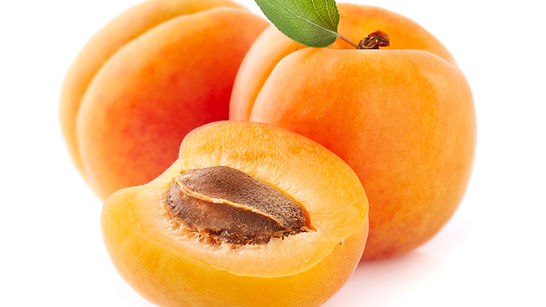Apricot

Nutrient Content : Vitamins & Minerals
(Based on 100g in raw form)
Fiber | Calcium | Iron | Magnesium | Phosphorus | Potassium |
|---|---|---|---|---|---|
2 g | 13 mg | 0.39 mg | 10 mg | 23 mg | 259 mg |
Sodium | Zinc | Copper | Manganese | Selenium | Choline |
|---|---|---|---|---|---|
1 mg | 0.2 mg | 0.08 mg | 0.08 mg | 0.1 mcg | 2.8 mg |
Vitamin A (RAE/IU) | Vitamin B1 (Thiamin) | Vitamin B2 (Riboflavin) | Vitamin B3 (Niacin) | Vitamin B5 (Pantothenic Acid) | Vitamin B6 |
|---|---|---|---|---|---|
96 mcg/1930 IU | 0.03 mg | 0.04 mg | 0.6 mg | 0.24 mg | 0.05 mg |
Vitamin B9 (Folate/Folic Acid) | Vitamin B12 | Vitamin C | Vitamin D | Vitamin E | Vitamin K |
|---|---|---|---|---|---|
9 mcg | 10 mg | 0.89 mcg | 0.89 mg | 3.3 mcg |
What It Helps:
How It Helps:
Rich in fiber which helps with constipation as well as maintaining regular bowel movement.
High in vitamin C, E, and zinc, which are all beneficial with supporting your skin health as well as preventing from vision weakening.
It's fiber conent also helps in lowering cholesterol and maintain blood sugar levels.
The carotene content in apricots helps protect against eye/vision deterioration.
Helps protect against cardiovascular diseases
Apricot kernel extract contains antibacterial properties
Contains anti-inflammatory properties
Tips & Other Info.
Buy organic if you can. If not wash well with a veggie wash and then rinse with cold water.
Use in salads as a topping, or make a fruit salad with it.
Use when making bread or muffins
Gardening Tips & Info.
Here are some planting tips and information if you want to have this plant in your own backyard (or front yard)

Planting Season

Harvesting Season

Pruning Season

Watering Schedule

Sunlight Exposure

Potted / In Ground
Plant in the fall (September-November) during its dormant season. Can be planted in a sunny location up against a wall.
Apricots are self fertile but when flowers have fully opened, can be pollinated by hand using a soft brush. | Summer time (June-August) | Spring and summer time pruning. | Feeding: Add sulfate of potash in winter (February) about 1 oz/sq.yd.. Add calcium ammonium nitrate during spring (March). Every 3 years add super phosphate in winter (February). Add organic mulch every year during spring (March-May).
Watering: During dry season give more water. | Full sun | In ground but can be grown in container (not pot bounded). In well drained soil with organic compost |

